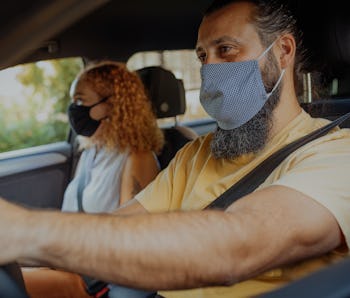Tech
Ready to sit in a tiny box with strangers again? Shared Lyfts are back.
You'll save money by splitting your ride with a stranger. But does anyone want to do that anymore?

With vaccinations on the rise, Lyft is relaunching its service that lets passengers share their rides with strangers. Shared rides were suspended during the pandemic, but they will be available again starting July 19 in Philadelphia, Chicago, and Denver, followed by additional markets in the coming months.
The idea behind shared rides is that by carpooling with strangers headed in the same direction, you can get a steep discount on your fare. Shared riders are also supposed to improve the environmental impact of ridesharing. Lyft always touted itself as positive for the environment because riders might stop using their own cars. But research has found that the advent of ridesharing hasn’t led to less use of private cars, but rather it’s taken the biggest hit on greener alternatives like public transit. Shared rides address environmental concerns somewhat by having individual riders buddy up.
Pandemic-related concerns aside, there were problems with shared rides even earlier.
Cramped and slow — Anyone who’s ever taken a shared ride with Lyft or Uber might have experienced wildly unpredictable rides that could sometimes be double or triple the duration to go the same distance as a standard ride, because the algorithms would poorly match riders and struggle to figure out efficient routes. If you’ve got somewhere to be, getting an unexpectedly long ride might not be worth $2-3 in savings.
Lyft says that it’s tweaking the program to make rides more predictable. Passengers will now be able to schedule rides up to half an hour in advance, which it says is supposed to help the company better match riders. You’ll save more money if you do this versus requesting a shared ride immediately, because the ride will cost less for everyone if the driver is able to take the most efficient (and fastest) route to drop you off.
There are also going to be new health safety measures. Despite lifting of such restrictions, drivers and riders will still be required to wear masks, and eating and drinking during rides is banned. Shared rides will also be limited to two riders — one in the back and one riding shotgun. That’s probably a good thing, pandemic or not — being squeezed up against a stranger’s body is not pleasant.
Business model — Uber has also offered shared rides, and reporting from Business Insider suggests the company at times was losing a billion dollars a year on them because it was heavily discounting rides in hopes that the affordable offering would entice people to start using Uber more. But the company needs to become profitable and if shared rides come back, Business Insider citing anonymous sources says the discount you get on a shared ride versus a standard one might decrease to around 20 percent, from a high of 50 percent historically.
That’s probably a good thing, if it means riders start to understand the real cost of the driver’s time and effort. But it would make it that much harder to stomach taking a shared ride considering the downsides. And who knows whether people will even feel comfortable enough given you really can’t know whether or not your fellow rider is vaccinated.